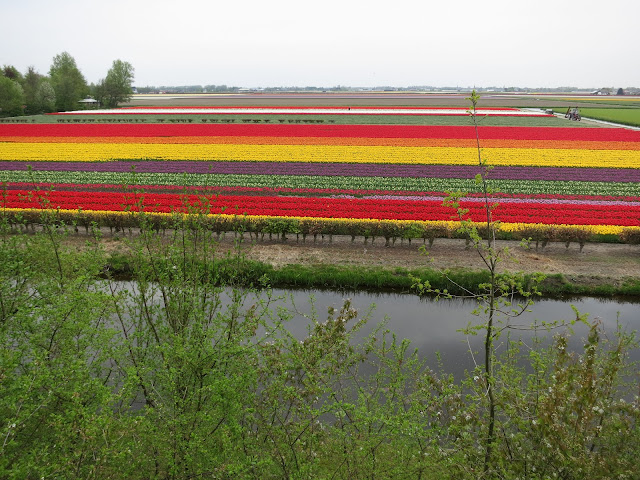 |
| Keukenhof Gardens |
 |
| Fields outside of Keukenof Gardens |
Also located in the gardens was a windmill where we learned some things about this iconic Holland machine. The gentleman operating it told us that the blades can be rotated horizontally depending upon the wind direction and the canvas covering the blades can be shorted when the wind is too strong, much akin to a sailboat sail. Most are/where used for pumping water or milling grain. He had one on his property for pumping water - with an electric backup when there is no wind.
No sooner do you pass into The Netherlands than the landscape begins to change. Canals large and small crisscross the fields and windmills dot the landscape. It could not be more flat.
The Netherlands are three meters below sea level and is sinking by a half centimeter per year. Amsterdam is a city that has been well preserved and is rich in history. The canals in the city are nothing but serene. We stayed in the Jordaan District of the city which has many quaint shops and a wide variety of restaurants. Rembrandt lived the last years of his life in this area.
I was fascinated to relearn some Dutch history. But it wasn't until we toured the church tower of Westerkerk that we learned that locations in New York City (originally named New Amsterdam) have Dutch origins- Harlem, Staten Island, Flushings, Bowery, Brooklyn and Coney Island to name a few. The Westerkerk Church tower was completed in 1632. It is built on wood pylons and it is beginning to lean. Rembrandt is buried here. Ann Frank was said to have written in her diary about this church's bells. We did not get the opportunity to visit the inside of the church, it was closed.
 |
| Very windy on the platform of Westerkerk Church tower |
 |
| Great views of the city from the platform of Westerkerk Church tower. |
I have never seen so many bikes. I admire their culture of biking and I wish more cities provided bike paths for their citizens like the Dutch. For every road, there is a bike path beside it, so cool! At the train station there was a two-story parking garage just for bicycles. We didn't see many nice bikes, mostly rusty, old things. The worst the bike, the less chance of it getting stolen. You could often hear a squeaky bike coming from a relative distance away.
George was eager to rent bikes but at first glance, it seemed dangerous, in reality Amsterdam has one of the lowest bike accident rates. It took some getting use to crossing the street and looking both ways for, not only cars and trams, but all the bicycles. They ring their bike bells which is helpful if you happen to forget to look, but they don't seem to slow up for anything except traffic lights...well most of the time. Plus texting and talking on their phones added to my concern. So we rented some bikes for several hours. It was easier than I thought. People get out of your way on a bike and it was much easier following a local Dutch biker, they are fearless and travel gracefully through busy intersections.
After 10 years of renovation and 375 million euros, the Rijk Museum opened this April. It is the Dutch National Museum and it is gorgeous both inside and out. Rembrandt, Vermeer and Frans Hals are the main attractions here, but I was equally captivated by a 1613 Dutch ship wreck recovered in 1976 with porcelain from China.
 |
| Artifacts recovered from 1613 Dutch ship wreck |
 |
| Entrance to Rijk Museum |
 |
| Stain glass dedicated to the artist on display |
I can't tell you why I found these hats so fascinating, but here is what I learned. These hats were recovered from a 1980 archaeological dig of 17th century whale hunters graves. Each skeleton was wearing their knitted woolen cap. The information plate in the museum stated that each cap was individualized; the men recognized one another only by the pattern of stripes on their caps.
The one museum that we did not get an opportunity to visit was the Anne Frank house, but we sure tried several times. The lines were very long and slow moving.
Another unique and popular tourist attraction in Amsterdam is the Red Light District. Easy to find and within the core of the city, we were astonished to see several families walking the streets in this area, albeit before the onslaught of darkness. It is something that you just have to see for yourself. You can say that Amsterdam has something for everyone!
Here's some more photographs of our trip at this link
http://flic.kr/ps/285kjt







